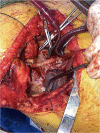Translocation of aberrant right subclavian artery to the ascending aorta-a treatment for dysphagia lusoria
- PMID: 36846846
- PMCID: PMC9949703
- DOI: 10.1093/jscr/rjad054
Translocation of aberrant right subclavian artery to the ascending aorta-a treatment for dysphagia lusoria
Abstract
Generally, an aberrantly coursing right subclavian artery (ARSA), also known as 'arteria lusoria', is an incidental diagnosis of no clinical consequence. Where correction is indicated, popular practice is for decompression via staged percutaneous +/- vascular methods. Open/thoracic options for correction are not widely discussed. We report the case of a 41-year-old woman with dysphagia secondary to ARSA. Her vascular anatomy precluded staged percutaneous intervention. The ARSA was translocated to the ascending aorta via thoracotomy, utilizing cardiopulmonary bypass. Our technique is a safe option for low-risk patients with symptomatic ARSA. It obviates the need for staged surgery and removes the risk of carotid-to-subclavian bypass failure.
Published by Oxford University Press and JSCR Publishing Ltd. © The Author(s) 2023.
Figures
References
-
- Polguj M, Stefanczyk L, Topol M. The epidemiological, morphological, and clinical aspects of the aberrant right subclavian artery (arteria lusoria). In: Epidemiology of communicable and non-communicable diseases. IntechOpen; 2016: 75–86.
-
- Shadman Baig M, Timaran CH. Upper extremity aneurysms. In: Sidaway AN, Perler BA (eds). Rutherford’s Vascualr Surgery and Endovascular Therapy, Chapter 84. Philadelphia, PA: Elsevier, 2018, 1095–108.
Publication types
LinkOut - more resources
Full Text Sources



